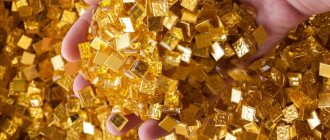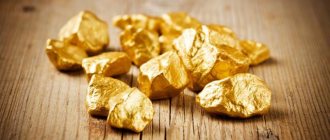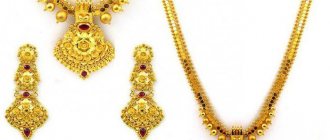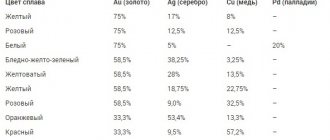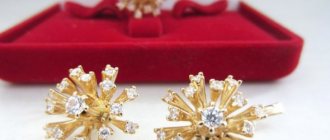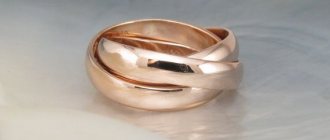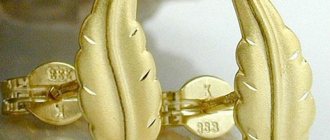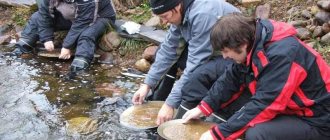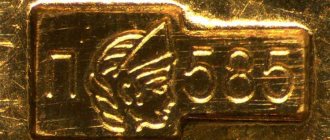Origin of gold on Igor Garshin’s website
Home
| Write |
Home > Natural Sciences > Earth Sciences > Geosphere Sciences > Gold Geology > Gold Formation
Alphabetical list of pages: | | | | | E (Yo) | | | | | | | | | | | | | | | | | | | | | | | | 0-9 | AZ (English)
| The process of origin of gold is still unknown to science. |
There are different versions of the origin of gold on Earth: meteorite, geonuclear, biogenic (see articles and news below).
Gold ore is a surface phenomenon, although gold is heavy and must have sunk into the core early in Earth's history. This means that the presence of gold in the lithosphere is of cosmic or biogenic origin [or somehow rose from the very depths].
To explain the origin of gold ores, geologists have created a hypothesis that is as beautiful as it is difficult to prove, according to which at great depths (tens of kilometers) hot, gas-saturated aqueous solutions are formed that have the ability to dissolve large amounts of gold. Squeezed into cracks under high lithostatic pressure, such solutions cool and crystallize at depths from hundreds of meters to several kilometers, releasing a useful component. [And this theory characterizes the “classical” geologists.]
Sections of the page about gold synthesis and metallogeny :
- Nuclear fusion of gold
- Biogenic accumulation of gold
- Metallogenic eras
- Geological epochs of gold formation [aurogenesis]
- Formation of gold deposits on Earth
- Articles on gold formation and gold forecasting
- News on gold metallogeny
Also see the geochronology page for information on supercontinents for each paleontological era.
Nuclear fusion of gold
Many heavy elements are synthesized in the interior of stars, but this is only true for atoms up to iron. Numerical modeling showed that gold, platinum
,
thorium
,
plutonium
and other heavy atoms are born during the merger of neutron stars. With such a merger, a portion of very hot matter weighing several Jupiters is thrown into space. When this plasma clot cools down to 10 billion degrees, nuclear reactions begin in it, creating superheavy atoms, and due to the decay of the latter, simply heavy ones like gold.
- Origin of gold. Gold
, as a chemical element, was formed during the collision of new stars. - Astrophysicists have explained the origin of gold in the Universe. Gold nuclei are formed during the nuclear decay of superheavy nuclei, and the latter - during the collision of neutron stars in a binary system.
Where did gold come from on Earth?
There are many versions - plausible, already refuted and completely fantastic. I will focus on the three most popular.
Hypothesis 1
Once upon a time, people thought that noble metals were formed in the depths of the planet and were brought to its surface due to volcanic processes. This assumption was not confirmed: it was proven that natural conditions on Earth were never suitable for thermonuclear fusion of heavy elements.
Hypothesis 2
According to some scientists, gold is a waste product of certain types of anaerobic bacteria. The influence of the microcosm on the migration of gold and the formation of natural ingots is indeed noted, but the biogenic hypothesis poorly explains the appearance of a new chemical element.
Hypothesis 3
Traditional science believes that the atomic composition of our universe was formed as a result of nucleosynthesis, divided into 3 stages:
- cosmological (primary, prestellar);
- stellar (synthesis of nuclei in the bowels of stars during combustion and explosions);
- synthesis under the influence of cosmic rays.
Before the formation of stars, the Universe consisted of elementary particles and radiation, was small and very dense. After the Big Bang it began to cool and expand. This was accompanied by primary nucleosynthesis, which resulted in the formation of light elements - helium and lithium.
2 billion years later stars appeared. Thermonuclear reactions began to occur in them, making it possible for elements heavier than lithium to appear. This is how silicon, vanadium, and aluminum arose; but pressure and temperature were still not enough to form nuclei with an atomic mass of more than 55.845 units (the mass of iron). Nuclear fusion of heavy elements can only be explosive.
The most viable hypothesis explains the origin of gold through gamma-ray bursts - powerful bursts of electromagnetic radiation in space. They accompany the death of stars - supernova explosions and mergers of neutron stars, as a result of which the emergence of elements with an atomic mass greater than that of iron is possible.
Metallogenic eras
Before considering aurogenic epochs, let's look at the epochs of general metallogenesis (age is given in million years):
- Vendian
(570-610) [close zircon peaks: 142, 300, 370, 425, 642]. Then a pause of about 400 million years [until the end of the Mesozoic and the beginning of the Cenozoic?]. - Middle Riphean
(1000-1350) [zircon peaks: 920, 1100, 1250]. - Early Riphean
(1350-1650) [zircon peaks: 1550]. - Svecofennian
(1650-2100): Svecofennian (
Vepsian
: 1650-1800) [zircon peaks: 1750]. - Svecofennian ( Calevian
: 1800-1920) [zircon peaks: 1950]. - Svecofennian ( Ludicovian
: 1920-2100) [zircon peaks: 2130].
(2400-2500). Before this there is a pause of 300 million years.
(2500-2800) [zircon peaks: 2650 (middle), 2730].
(2800-3000) [zircon peaks: 2900 (middle)].
At Voitekhovskaya
a number of gold mining epochs are noted, among which
the Late Archean
(2.9-2.6 billion years ago) [Late Lopian era], represented by deposits of
the Witwatersrand
(South Africa),
Kalgoorlie
(Western Australia),
Hemlo
,
Yellowknife
, and characterized by the widespread development of active volcanic and post-volcanic processes, stands out .
This is followed by maxima of 1.7-1.6 [end of Svecofennian], 0.8, 0.4-0.24 and 0.2-0.01 billion years ago. The Paleozoic
and
Meso-Cenozoic
maximums mean a new activation of the gold mining process. Moreover, the periodicity of gold mineralization maxima approaches the periodicity of orogenic endings in the tectonic history of the Earth.
Briefly about the properties, history and use of gold
Gold is the only metal that, in its pure form, has a beautiful bright yellow color. It has a good shine, which increases when polished. Density - 19.3 g/cm3, melting point - 1063°C, Brinell hardness - 20, color - yellow.
The average gold content in the lithosphere is 4.3 x 10-7% by mass.
People have been mining gold since time immemorial. There are several main methods for extracting gold, the main ones being washing river sand and extracting gold-bearing rock in mines. Gold can be extracted from gold-bearing rock by amalgamation, chlorination, or cyanide.
In total, more than 140 thousand tons of gold have been mined by humanity. Of this, more than 40% went to jewelry, and 12% to technical purposes.
Collected in one place, gold mined throughout history would form a cube with an edge equal to 19 m, that is, the height of a five-story building (while the ore and sand from which this gold was extracted would represent a mountain more than 2.5 km high). The gold currently mined throughout the world in one year would fit in a medium-sized room.
There are primary deposits of gold, placers into which it falls as a result of the destruction of ore deposits, and deposits with complex ores in which gold is extracted as an associated component.
Major gold mining countries: South Africa, USA, Australia, Canada, China and Russia.
In Russia, Erofey Markov is considered the first gold miner, a monument to whom stands in the city of Berezovsky near Yekaterinburg.
Natural or native gold, as a rule, is not pure and its purity ranges from 500 to 950. The main impurities in native gold are silver and copper, as well as many other elements, therefore, to achieve high purity, it is subjected to refining (purification) at special enterprises.
Refined gold is produced in bars of various weights - 1 gram, 5 grams, 10 grams, 50 grams, 100 grams, 500 grams, 1,000 grams, 12,000 grams, or in the form of gold coins weighing from 1/2 gram to 5, 10 and even 100 kg, as well as in the form of tapes, strips, foil, wire and other semi-finished products.
The gold content in bars and gold coins is about 99.99%, the remaining hundredths and thousandths of a percent are impurities (lead, iron, antimony, bismuth, copper or silver, etc.). The amount of impurities is regulated by GOST.
Gold is a very ductile and soft metal; it can be rolled into sheets up to 0.0001 mm thick. (“leaf” gold), and from one gram draw a wire 3.5 km long.
Gold does not oxidize in air and is resistant to moisture, insensitive to acids, alkalis and salts. The exceptions are a mixture of hydrochloric and nitric acids in a ratio of 3/1 (regia vodka), sulfuric acid in combination with manganese or nitric acid, as well as hot selenic acid, in which gold dissolves quite easily.
When combined with mercury, gold forms an amalgam (once this property of gold was used for “hot” gilding of jewelry: the jewelry was rubbed with amalgam and heated over hot charcoal; when heated, the mercury evaporated, and a thin layer of pure gold remained on the product).
In the jewelry industry, pure gold is used to form alloys of precious metals. Gold alloys are ideal materials for making jewelry. Unlike too soft pure gold, they are more durable and wear-resistant, and when adding various alloys, they easily change color to white (white gold), red, green, pink, etc.
Geological epochs of gold formation
It turned out that the distribution of deposits in geological time has a pronounced discrete nature. The emergence of the most significant gold deposits is associated with certain stages in the development of the Earth, and they are confined to geological formations of a special type. [Let us consider these aurogenic epochs against the background of general metallogenic ones.]
- 3.8-2.8 billion years ago, ore formation began on Earth. This was the Archean [lower and middle Archean] metallogenic era, covering the era of the proto-continent Vaalbara. Giant gold deposits of the most ancient shields were formed: Porcupine, Kirkland Lake
- on the Canadian Shield;
Kalgoorlie
and others - in Western Australian;
Kolar Goldfields
- in Hindustan;
ore fields of Western and Southern Africa. In all these deposits, gold is contained in thick quartz veins. The deposits of this era are very unique and in many ways unlike younger ones. Thus, the Yellowknife
(translated from English as the Yellow Knife) is represented by a suite of ore veins up to 4 km long, with consistently high metal contents. And the largest, continuously mined vein of the Kirkland Lake deposit was traced for 2 km. But, perhaps, the most characteristic is the stable high vertical gold content, due to which the mining depth of many deposits exceeded 2000 m, and at the unique Witwatersrand deposit in South Africa reached 3.5 km [already 5!]. - 3.2-2.5 billion years ago, the richest deposit on our planet was formed - the Witwatersrand
in South Africa. This orogeny also belongs to the Archean [Upper Archean - more precisely, Mesoarchean-Neoarchean] metallogenic era, coinciding with the era of the Kenorland proto-continent. - 2.5-1.9 billion years ago the Homestake gold deposits in the USA, Sukhoi Log in the Baikal region and the Boliden gold pyrite deposit in Sweden were formed. This geological process occurred in the Early Proterozoic metallogenic era, almost coinciding with the era of the Columbia continent.
- [Nothing is said about aurogenesis in the Middle Proterozoic (1.9-1.65 billion years ago - gold of Sudan), Early Riphean
(1.65-? billion years ago - Yakutia, Sudan) and
Late Riphean
(?-0.57 billion . years ago - massive development of copper sandstone deposits, manifestation of hydrothermal deposits of gold, copper, tin and tungsten) metallogenic eras.] - Almost 1.5 billion years [2 Willis cycles = 8 galactic years] lasted a geological pause in the formation of gold [with the exception of the Lower Paleozoic deposits of Southern Siberia - Eastern Kazakhstan], which was replaced by 400-250 million years ago [Upper Paleozoic: Devonian - Permian] bright and a very productive stage ( Caledonian
metallogenic era).
During this period, two powerful mountain belts emerged - East Australian
and
Ural-Mongolian
. Each of them is the richest gold mining province, from whose deposits thousands of tons of gold were extracted. - 250 million years ago [the end of the Paleozoic - Mesozoic] a new cycle of ore formation began ( the Hercynian
metallogenic era): folded belts grew around the Pacific Ocean depression and numerous gold deposits in Chukotka, Kolyma, Primorye and the Amur region. The Caledonian and Hercynian metallogenic epochs (as well as the Alpine epoch that replaced them) lie in the middle of the epoch of the proto-continent Pangea. - [It is also not said about the formation of gold in the next - Alpine
(50 million years ago - Cenozoic [Paleogene]) metallogenic era, when the gold deposits of Kamchatka, the Philippines and the Caribbean were formed.]
That is, in the geological history of the Earth there were 2 main episodes in the formation of gold deposits. The first covers the very initial stages of the Earth's development, and the second covers the last few hundred million years.
(Based on the article “Gold is a Mineral”)
Interesting facts about gold
Throughout their history, earthlings have mined a relatively small amount of gold - approximately 172 thousand tons
. Most of the reserves of this valuable metal are now located in the Earth's core. If all the remaining gold on the planet were combined into one cube, then each side of this cube would be equal to 21 meters.
Gold does not corrode
and very few chemicals can damage it. That is why it remains shiny even after lying somewhere in the ground for more than a thousand years.
10 Lost Treasures Around the World
75% percent
of all the gold mined on the planet was mined
after 1910
.
Compared to diamonds, gold is very rare.
Gold is a very heavy metal
, although quite soft.
Absolutely pure gold is such a soft metal that it can be crushed by hand. Gold is 19.3 times
heavier than water, and one cubic meter of gold weighs
19,300 kilograms.
The largest solid piece of gold ever found weighed approximately 90 kilograms
, it was discovered in Australia.
There are huge volumes of gold in the world's oceans, but in very low concentrations - 1-2 parts per 10 million parts
, that is, in one cubic kilometer of sea water there are from
10 to 20 kilograms
of gold.
In general, gold has found application in many areas besides jewelry. For example, wires and many computer parts are made partly from gold. It is also an important component for printing equipment, photography, spacecraft, and dyes. There's even edible gold
used in cooking!
For example, the famous liqueur Goldschläger
- Swiss schnapps based on cinnamon - sold in a bottle
with the finest gold flakes
.
One liter of liquor usually contains about 13 grams
of pure gold.
Researchers from Tel Aviv (Israel)
found a new use for gold.
They found that gold nanofibers in artificial heart muscle can enhance electrical signals and restore heart function
after heart attacks.
It was also found that injections with pure gold can relieve symptoms of arthritis.
. Gold is known to be used in dental crowns due to its resistance to corrosion. So the medical use of gold is not new for a long time.
Formation of gold deposits on Earth
One of the ways of forming gold deposits is the precipitation of gold from hydrothermal
(from the Greek “hydros” - “water” and “therme” - “heat”) of water in areas where deep solutions reach the bottom surface. But before gold appears in solution, unique conditions must arise: in particular, the presence of certain active compounds in the water is mandatory. For example, gold dissolves well in the presence of potassium or sodium cyanide (cyanides), as well as in some organic acids.
Occasionally, gold is brought in by solutions in the form of microscopically small particles. For particles to settle, the flow of hydrothermal waters must be truly enormous - after all, the maximum gold content in a saturated solution is only 0.014 ppm. Such streams pour out in the form of “black smokers” at the bottom of the oceans, along giant faults in the earth’s crust, where lithospheric plates move apart.
High concentrations of gold have also been noted in zones of hydrothermal activity on island arcs and continents. Here it manifests itself in the form of hot springs, geysers, mud volcanoes (Valley of Geysers in Kamchatka, Yellowstone National Park in the northern USA). In New Zealand, a significant amount of gold was found in the pipes of a power plant operating on natural hydrothermal waters. It turned out that in the nearby hot lake Champaign Pool, gold is deposited at a rate of 4 kg per year, and after 50 thousand years a large deposit will appear here.
In areas where oceanic and continental plates collide, the denser crust of the oceanic plate subducts and is pushed under the continental plate. At the same time, chains of volcanoes called volcanic island arcs appear on the Earth’s surface (for example, Japan, the Kuril Islands). Gases and superheated solutions released from the lava dissolve and transport gold to the surface. They react with groundwater and host rocks to form massive gold pyrite ores.
.
Gold-bearing quartz veins occur in many old mountain belts. As a rule, these veins gravitate towards ancient fault zones. Gold is found in them together with quartz, minor sulfide minerals (for example, sulfur pyrites
-
pyrite
), often with carbonates.
Vein deposits are characteristic of volcanic belts formed over 3 billion years ago (Archaean). They are common on ancient shields in Canada ( Yellownaif
- node 7 and
Timmins
- node 8), Australia (
Kalgoorlie
- node 22), Zimbabwe (node 20) and Brazil and arose almost simultaneously throughout the world. Many geologists associate this with the emergence of proto-continents and the beginning of their movement.
True, similar gold deposits are also found in later rocks, which are less than 500 million years old: in the shales of South Australia ( Bendigo
), in northeastern Canada (
Nova Scotia
), in Europe (
Huelva
in Spain and
the Massif Central
in France), as well as in very young (in a geological sense) deposits (for example, the famous
Mother Deposit
in California).
In vein deposits, numerous quartz veins cut through heavily altered host rocks. Repeated penetration of solutions into the crack is expressed in a banded filling of it with minerals: “ribbons” of white quartz alternate with “ribbons” of sulfides and gold. Each time the next cycle of opening the vein and introducing a new portion of solutions occurs, carbon dioxide boils, as in an open bottle of mineral water. In the solution itself, the chemical equilibrium changes sharply and gold precipitates. It is possible that similar processes are activated in fault zones during an earthquake.
In other deposits, gold occurs in dispersed form. However, the general patterns remain the same: gold-bearing solutions penetrate into the host rocks along faults and cracks. This is how one of the largest gold deposits appeared - Muruntau
in the Tien Shan (Uzbekistan). Its gold reserves are estimated at 4.5 thousand tons.
Deep pockets of magma sometimes also contain significant amounts of gold and copper. At great depths, ore bodies with high contents of molybdenum, copper and gold are formed from solutions released from cooling magma. When these bodies end up on the surface as a result of erosion, they are used to mine copper and molybdenum, and gold, the content of which is usually low, is recovered along the way.
Origin of gold
Currently, there are several theories about the appearance of gold on Earth. They can be divided into two large groups.
According to the first, gold appeared on Earth after its formation as a result of the massive fall of celestial bodies containing this metal. The gold that reached the surface was distributed in the crust and from there, as a result of volcanic and tectonic activity, it was again brought to the surface.
According to the second group of theories, which is supported by most scientists, gold was part of the matter that originally formed the Earth. Then, also as a result of volcanic processes, it was carried out from the depths and distributed in the crust and came out.
In both cases, we owe the formation of gold deposits to processes in the earth's crust, which led to the release of solutions containing gold to the surface.
It’s hard to believe, but at depth, at high temperatures and pressure, in the presence of acids, sulfur and other substances, solutions of gold and quartz were formed. As a result of natural convection processes, hot solutions along faults and cracks in the crust rose upward to the surface of the earth. As it rose, the temperature and pressure dropped, which led to the decomposition of unstable compounds of gold with sulfur and the crystallization of quartz. In addition, sulfur compounds formed sulfides - pyrite, galena and arsenopyrite. The result of all these processes was the appearance of quartz veins with gold inclusions, as well as various sulfide gold deposits.
Differences in the formation conditions and chemical composition of the veins cause differences in the forms and amounts of gold they contain. In most of them, gold is found in the form of tiny grains, practically invisible to the naked eye. You can work at a rich deposit for a long time, but never see gold in the rock. However, occasionally there are gold crystals of different shapes and sizes, from several grams to tens of kilograms.
JEWELERY METALS - CATALOG | JEWELERY METALS - GUIDE
All about gold | All about silver | All about platinum | All about palladium
Gold alloys and their colors | Properties of gold as a metal | Gold deposits | History of gold jewelry since ancient times | History of gold mining from early times | Assays for gold | Table of physical and chemical properties of precious metals | How to check gold for authenticity?
Share this article with your friends
Works by designers from the JEWELIRUM catalog
- Co.Cos Jewelry
- Co.Cos Jewelry
- Taiga Jewelry, Tomsk
- Taiga Jewelry, Tomsk
- Ilya Maksimov, Crimea
- Ilya Maksimov, Crimea
- UBIRING
- UBIRING
- Diamonds are Forever
- Diamonds are Forever
- Rings in natural style, Sergacheva Jewelery
- Earrings with pearls, Sergacheva Jewelery
- Cabochon ring, Minty Sky
- Fly earrings, Minty Sky
- Ring, Precious Park
- Ring, Precious Park
- Snake skin ring, Stoyanova Jewelery
- Chain earrings, Stoyanova Jewelery
- Children's pendant - stick, Matthew&Daniel
- Pendant for a child, Matthew&Daniel
- Bracelet, Svetlana Subbotina
- Ring with Slavic symbols, Svetlana Subbotina
- Indian style ring, Anna Goffman
- Indian style ring, Anna Goffman
- Earrings, ISTA
- Geometric ring, ISTA
- Earrings with enamel, PNJewelry
- Ring with enamel, PNJewelry
- Ring, Khramtsova Jewelry
- Ring, Khramtsova Jewelry
- Wedding rings to order, obruchalki.com
- Wedding rings to order, obruchalki.com
- Earrings, Yuri Bylkov
- Earrings, Yuri Bylkov
- Titanium bracelets, LanaMuransky
- Titanium pendant, LanaMuransky
- Brooch Elephant (after Salvador Dali), THING
- Ring Veil, THING
- Mace earrings, VLADIMIR MARKIN
- Cufflinks, jewelry mechanics, VLADIMIR MARKIN
- Drop-shaped ring, EKATERINA TOLSTAYA
- Drop-shaped earrings, EKATERINA TOLSTAYA
- Necklace with amber, LETA
- Earrings with amber, LETA
- Children's earrings, combinable, FASHBY
- Children's earrings, combinable, FASHBY
- Ring of architectural form, Elizaveta Malafeevskaya MANU_L
- Architectural bracelet, Elizaveta Malafeevskaya MANU_L
- Set Ginkgo Leaf, SHABUT JEWELLERY
- Brooch Wearable porcelain, SHABUT JEWELLERY
- Architectural ring, GEOMETRY
- Brooch, porcelain, GEOMETRY
- Necklace made of polymer clay, LICORNE ART
- Brooch made of polymer clay, LICORNE ART
- Ring, avant-garde, VALERY SEREDIN
- Bracelet, avant-garde. VALERY SEREDIN
- Wooden set, Scandinavian/Japanese minimalism, VLADIMIR SHESTAKOV
- Ring, Scandinavian/Japanese minimalism, VLADIMIR SHESTAKOV
- Earrings, TON ANT
- Ring, TON ANT
- Architectural ring, ANCHOR
- Architectural necklace, ANCHOR
- Earrings, GOHFELD JEWELLERY
- Necklace, GOHFELD JEWELLERY
- Massive ring, YAKISCHIK
- Designer jewelry, YAKISCHIK
- Architectural ring, ONE DAY ART
- Architectural ring, ONE DAY ART
- Brooch, bionics, VALERIYA MARKOVA (TESSA)
- Unclosed ring, bionics, VALERIYA MARKOVA (TESSA)
- Ring, bionics, BEAVERS
- Earrings, bionics, BEAVERS
- Earrings, asymmetry, VAGANOVA JEWELRY
- Airplane ring, VAGANOVA JEWELRY
- Flower ring, ALCHEMIA JEWELLERY
- Set, ALCHEMIA JEWELLERY
- Pendant-cat, ethnic, STUDIO OF ILYA AND VERA PALKIN
- Earrings, STUDIO OF ILYA AND VERA PALKIN
Comments
- Den
Thank you. Interesting and useful.
5 years ago Reply

